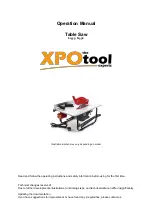
6
4.0
Glossary
Some terms relevant to the scroll saw:
Beam strength:
A blade’s resistance to backward
deflection caused by pressure of the workpiece.
Bevel edge cut:
Tilt of blade between 0° and 45° to
perform angled cutting operation.
Blade drift:
Deviation of blade from a straight line.
The smaller the blade, the more prone to drifting.
Blade tracking:
How the blade moves through the
cutting path.
Contour cut:
Cutting outside the workpiece line.
Crosscut:
A cut made across the grain of a
workpiece.
Deflection:
Tendency of blade to be pushed
backward or sideways under pressure from the
workpiece.
Feed rate:
Linear travel of workpiece into blade.
Freehand:
Moving the workpiece into the blade
using only the hands, without a fixed positioning
device.
Fret work:
Cutting inside the workpiece; also called
open work, or pierce cutting.
Kerf:
The resulting cut or gap made by the blade.
Kickback, or Lift:
The tendency of workpiece to
rise off the table due to being caught by the blade.
Leading edge:
Edge of workpiece that first gets
pushed into blade.
Parallel:
Position of saw arm equal in distance at
every point to the table surface.
Parallel link:
style of scroll saw in which a motor
pushes rods in upper and lower arms that move
articulated arms holding the blade. (The JET scroll
saw is this type.)
Perpendicular:
90° (right angle) intersection or
position of vertical and horizontal planes, such as
saw blade to table.
Pin-end blade:
Blade that requires a pin to secure
it to the saw. (These are not suitable for intricate
fretwork.)
Plain-end blade:
Blade that slides into a clamp
without need of a pin holder. These are preferred for
delicate fretwork. (The JET scroll saw uses this
type.)
Rake angle:
Angle of a blade tooth in respect to a
line perpendicular to the back edge of blade.
Relief cut:
Extra cut to remove waste material and
prevent the blade from binding when cutting a curve.
Rip Cut:
A cut made along the grain of the
workpiece.
Scroller:
User of a scroll saw. Sometimes called
“scroll-sawyer” or “scroll-sawer”.
Scroll work:
General term for designs with spirals
and rolling curves.
Stack cutting:
Placing multiple workpieces
together for simultaneous cutting. (CAUTION:
Pieces must be properly taped or glued together to
prevent sliding.)
Throat capacity:
Distance from blade to body
column; identifies maximum workpiece size.
Trailing edge
: Edge of workpiece that last contacts
blade.







































